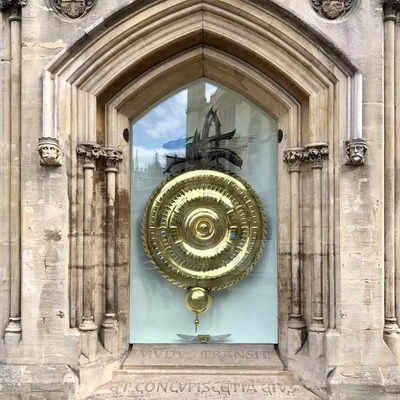Trending
World famous Corpus Clock: A time piece and a haunting work of art
The Corpus Clock in Cambridge, featuring an unsettling creature called the Chronophage, is a unique blend of art and horology. Designed by John C. Taylor, it uses LED rings instead of traditional hands and numbers. Unveiled by Stephen Hawking in 2008, it reflects on the passage of time and mortality.

Corpus Clock
This clock is accompanied by gothic sounds, conjuring deep reflections on the passage of time and mortality.
A ripple in time

Situated right in the heart of Cambridge, the Corpus Clock is a beauty combining art and horology
The design of the Big Bang-inspired clock comes from the world of physics, where ripples spread out from a central axis, from the origin of time. This is a subtle yet profound reminder of the origins of the universe, this makes the clock not only a timekeeper but also a storyteller about the cosmos.
The chronophage: The time eater
Sitting on the side of this clock is an unexpected and even somewhat an alien creature, the Chronophage, or as its name suggests, "time-eater." This grasshopperish creature merely snaps its mouth shut every minute, marking the eating away of time as it relentlessly moves forward. Extremely riveting yet disturbing, this scene leaves one to remember the implacable motion of time.
A bizarre showpiece
This is probably the most conspicuous feature of the Corpus Clock: it does not apply conventional numbers or pointers with digits. Instead, it makes use of three concentric rings of LEDs to display hours, minutes, and seconds in a way that challenges the viewers on how they may have perceived and read time previously. This has added to the mystique of the Corpus and has attracted several tourists around the globe.
The sound of passing time
The clock doesn't call out to every passing hour with jarring chimes or a ringing bell, but instead makes pitifully dreadful rattling chains and hammer pounding on a wooden coffin, all symbolising the motif of mortality and time. Thai ahrsh reality is pointed by the Latin inscription on its base: "Mundus transit et concupiscentia eius," which means, "The world and its desires pass away."
What makes the clock gothic?
The Chronophage which sits atop the clock makes it look eerie and mysterious. It is based on the concept of John Harrison's grasshopper escapement of 1725, a mechanical invention that greatly improved the accuracy of pendulum clocks. In this way, the Corpus Clock pays respects to those who advanced the nature of timekeeping as espoused in modern horology.
How did the clock come into being?

This clock was unveiled 2008 by great physicist Stephen Hawkin
From 2001 to 2008, John C. Taylor had collaborated with the local region's engineers, like Huxley Bertram, in designing Corpus Clock. Being very much fascinated by modern art, he intended to construct a peculiar clock where he would allow the clock to be upside down. He made the clock upside down by unearthing the grasshopper escapement from John Harrison. This design required underwater engineering in one of the secret Dutch military research institutions.Later, a Cambridge University student explained that this escapement mechanism which keeps the timepiece accurate, while friction has been kept to a minimum.
This clock was unveiled 2008 by great physicist Stephen Hawking, which subtly gave a status to this piece of horological art.
End of Article
FOLLOW US ON SOCIAL MEDIA










